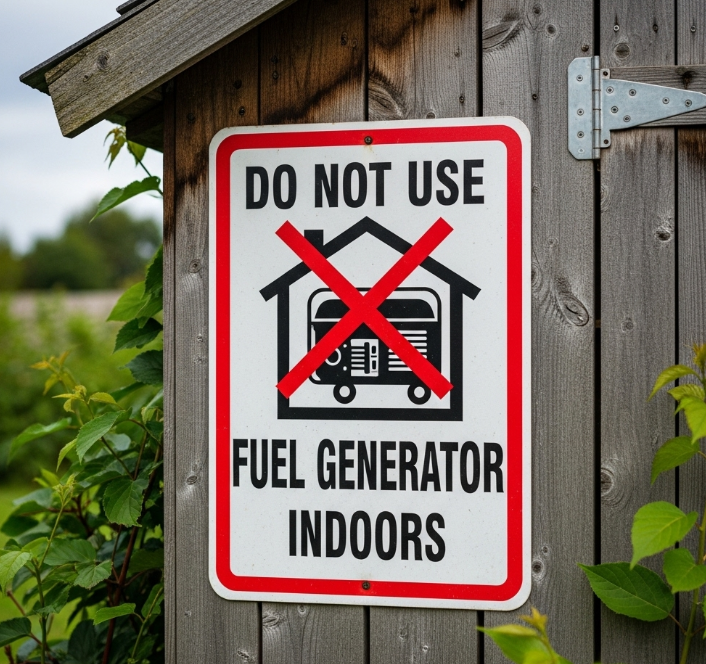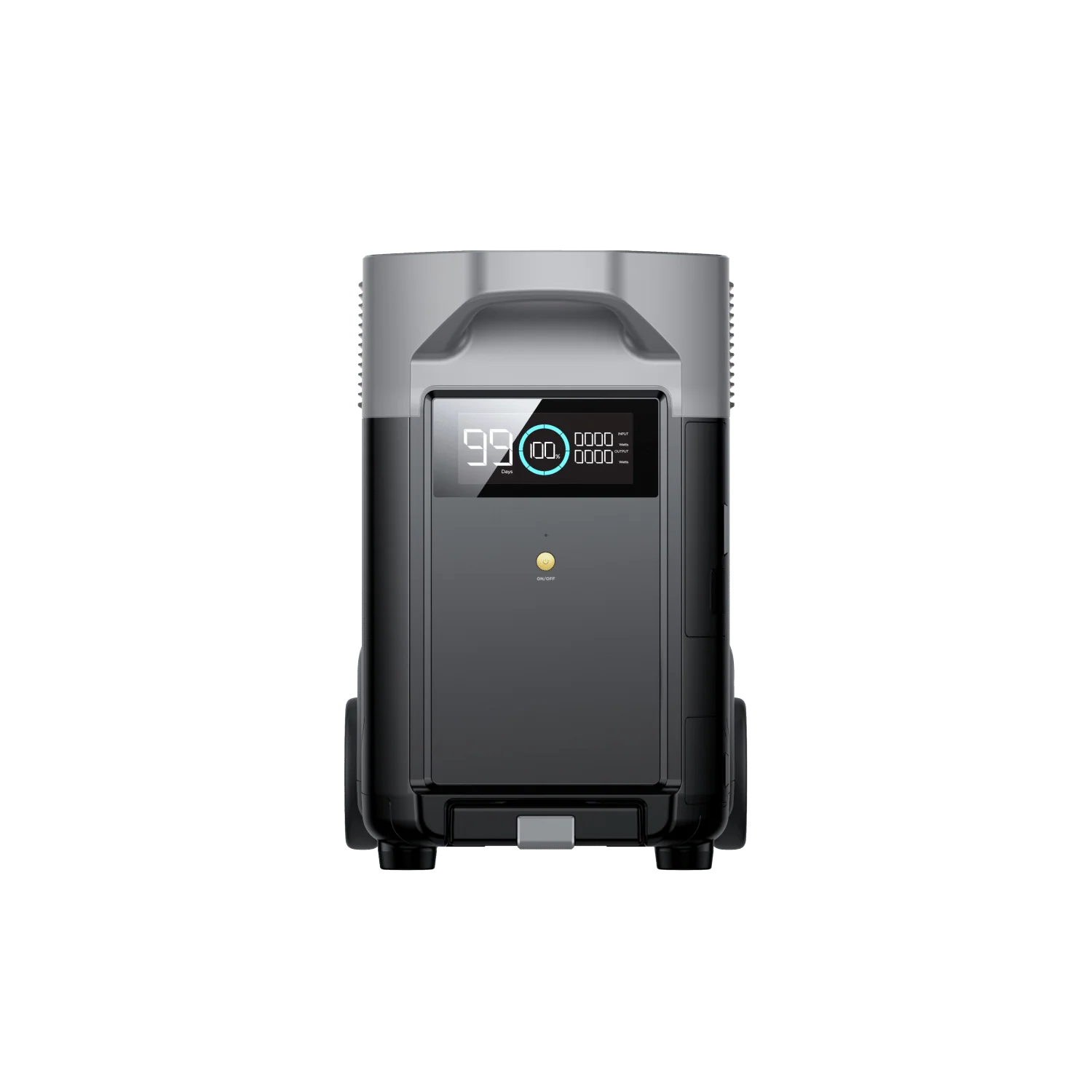Are Backup Batteries Safe for Indoor Use During Storms?
When weather officials issue a storm warning and a power outage is coming, your most pressing question is likely this: that backup battery you're counting on—can you truly run it safely overnight in your living room?
Let's get straight to the point and give you the direct answer.
The Answer Is: Absolutely Safe, on Three Conditions
Yes, you can use a high-quality, modern power station completely safely indoors. Three clear, easy-to-check rules build this peace of mind:
● ✅ The Right Battery Type: It must use the safest battery technology available for home use: Lithium Iron Phosphate (LiFePO4) - a special type of lithium battery that's much safer than regular ones.
● ✅ A Smart Safety System: It must have a powerful Battery Management System (BMS) - think of it as a smart computer that watches over the battery 24/7 to keep it safe.
● ✅ Correct and Safe Use: You need to follow basic safety rules, which are essential for getting the technology's full safety benefits.
If you meet these three conditions, you can rest easy using your power station through any storm. The careful engineering of modern technology supports this confidence, since engineers design these systems specifically for tough situations. Let's dig deeper so you can fully understand why.
Why Storm-Related Worries Are More Than Just a "Power Outage"
On a normal day, you might not think twice about a backup battery. But storms create unique challenges that turn small concerns into real, pressing issues.
This happens because storms create two key, extreme conditions: ① long, non-stop operation (since outages can last for days) and ② a completely closed indoor space (because you must seal doors and windows against the weather). These factors create our most specific and real fears:
The Fear of Overheating and Fire
When you force a unit to run in "marathon mode"—powering a refrigerator for 72 straight hours, for example—can its cooling system handle the job? Will it overheat under this non-stop heavy use?
The Worry About Invisible Dangerous Gases
With doors and windows sealed shut and no fresh air coming in, you have to ask: does this quietly running device release any harmful gases, like deadly carbon monoxide, into our home?
The Danger of Water and Electricity
Heavy rain can cause leaks. If water gets near the running power station, what risk do you face of a short circuit or, even worse, a dangerous electrical shock?
These situations represent the main challenges that modern power station safety technology addresses.


Understanding the "Peace of Mind" Technology
Your confidence in indoor battery use doesn't come from marketing claims; it comes from real technology designed to handle the risks above.
The Core Safety Foundation: The "Super Stable" LiFePO4 Battery
In simple terms: This battery type proves ideal for home use because it stays extremely stable, has almost no risk of overheating, and creates zero harmful gases.
Here's why this matters:
● Amazing Heat Resistance: The molecular structure of LiFePO4 (Lithium Iron Phosphate) works like super-strong concrete—incredibly tough. It won't catch fire until it reaches over 932°F (500°C), a temperature that's almost impossible to reach in your home. This completely solves the fear of overheating, even during the "stress test" of a long storm outage.
● Absolutely No Dangerous Fumes: Unlike old lead-acid car batteries that needed fresh air, LiFePO4 technology runs completely clean. This is critical when you're stuck inside during a storm with all windows closed. Power stations like the EcoFlow DELTA Series create no fumes at all, having zero impact on your indoor air quality.


The Smart Guardian: The "Always-Watching" Battery Management System (BMS)
In simple terms: The BMS works as the power station's smart brain, stopping nearly all potential electrical dangers like short-circuits and overloads before they can hurt you.
Here's how it protects you: The BMS in an EcoFlow power station uses a network of sensors to watch health and safety in real-time, providing over a dozen active protections that prove crucial during a storm:
● Overload Protection: If you plug in too many high-power devices in the rush of an outage, the BMS will instantly control the output to prevent system failure.
● Short-Circuit Protection: This handles the fear of water contact. If the system detects a short, it cuts power instantly to prevent a dangerous event.
● Over-Temperature Protection: This works as a watchful guard, constantly checking heat levels to ensure the unit stays cool and safe during long hours of operation.
● Overcharge/Discharge Protection: If grid power comes back and you forget to unplug the unit, the BMS automatically stops the charging process to protect battery health and safety.
Your Safety Guide: From Smart Selection to Safe Operation
Understanding the technology is the first step. The next step puts that knowledge into practice. This guide will walk you through making the right choices and following the right steps.
Step 1: Choose Correctly to Avoid Risk from the Start
Choosing the wrong product creates a safety risk by itself. A unit with too little power will cause overloads, while one with too little storage capacity won't meet your essential needs.
Figure Out Your Power Needs:
| Need Level | Typical Storage (EcoFlow Example) | Powers These Devices | Safety & Comfort Benefits |
| Basic Emergency | 1-2 kWh (e.g., EcoFlow DELTA 2) | Phones, internet router, lights, laptop. | Keeps critical communication lines and basic lighting working. |
| Home Comfort | 2-5 kWh (e.g., DELTA 2 Max) | Basic devices + refrigerator, fan, TV. | Keeps food safe (fridge stays on) and maintains basic quality of life to reduce stress. |
| Whole House Backup | 5kWh+ (e.g., DELTA Pro System) | Connects to home circuits to power air conditioning, water pumps. | Provides non-stop power for critical equipment like medical devices or basement pumps. |
Consider Flexibility and Charging Options:
During a long storm, having multiple ways to charge becomes a safety feature. A good power station should support several charging methods:
● Fast AC Charging: To quickly refuel when grid power briefly comes back.
● Solar Charging: To achieve true energy independence during a complete grid failure.
● Car Charging: As a reliable emergency backup option.
Step 2: Follow the "Golden Rules" for Indoor Use
This is your positive checklist for safe operation:
- High and Dry: Place the unit on a stable, dry surface, away from any potential leaks or flooding.
- Give It Breathing Room: Make sure at least 6 inches (15 cm) of clear space surrounds the unit, especially the cooling vents, for good heat release.
- Use Original Cables: This provides the best way to guarantee charging safety and efficiency, since manufacturers perfectly match them to the BMS protection settings.
- Correct Order: Plug your device into the power station first, then turn on the AC output. When done, turn the AC output off before unplugging the device.
- Keep Hands Dry: A basic rule of electrical safety when you operate any electrical device.
Step 3: Stay Alert and Avoid Common "Dangerous Mistakes"
This is your "don't do" checklist:
● ❌ Never Use a Car Battery Indoors: This is the most dangerous mistake. Lead-acid car batteries can release flammable hydrogen gas and manufacturers design them only for well-ventilated engine areas.
● ❌ Never Ignore a Warning: If your EcoFlow unit beeps or the app alerts you to an overload or overheat condition, stop use right away and check the situation. The BMS works as your last line of defense; listen to it.
● ❌ Never Bring a Gas Generator Indoors: If you use a gas generator to recharge your power station, you must keep the generator outside, far from doors and windows, to prevent deadly carbon monoxide poisoning.
● ❌ Never Use Damaged Equipment: If a cable shows wear or the unit's case appears cracked or swollen, stop using it immediately.
● ❌ Never "Chain" Power Strips Together: Do not plug one power strip into another. This creates unpredictable load conditions and creates a serious fire risk.
● ❌ Never Run Cords Through Water: It seems obvious, but in an emergency, you can overlook this. Make sure all electrical cords stay above any standing water.


Common Questions and Answers
Q1: Do EcoFlow power stations create carbon monoxide like a gas generator?
No. EcoFlow power stations run on battery power and create zero harmful gases. They don't burn fuel, so no risk of carbon monoxide exists, making them perfectly safe for indoor use.
Q2: How long can I safely run my EcoFlow unit indoors during a storm?
You can run it safely for as long as the battery holds charge. Its storage capacity (how much energy it holds) sets the limit, not a time limit that safety concerns create. Engineers design it for continuous, safe operation.
Q3: What should I do if my basement floods near my EcoFlow power station?
Your personal safety comes first. If you can do so safely, unplug and move the unit to a higher, dry location right away. Never operate any electrical device in or near standing water.
Q4: What's the difference between the EcoFlow RIVER and DELTA series?
The RIVER series is designed for portability and powering everyday devices for camping or short outages. The DELTA series offers much larger storage capacity and higher power output, which engineers design for serious home backup and powering demanding appliances like refrigerators.
Q5: Can I charge my EcoFlow power station with my gas generator?
Yes. You can use a gas generator to recharge your EcoFlow unit, but you must always operate the generator outdoors in a well-ventilated area to prevent carbon monoxide poisoning.
Final Thoughts about Choosing a Backup Battery
When facing a storm, choosing a modern backup battery from a trusted brand like EcoFlow—built on LiFePO4 technology and managed by an intelligent BMS—represents an extremely safe choice. By following clear safety guidelines on what to do and what to avoid, you can confidently power your home. It provides not just light and convenience, but the most valuable thing in an uncertain situation: peace of mind.